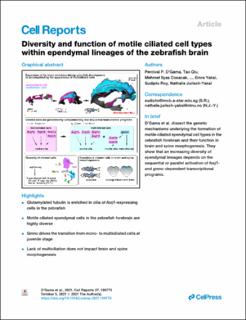| dc.contributor.author | Dgama, Percival Paul Menino | |
| dc.contributor.author | Qiu, Tao | |
| dc.contributor.author | Cosacak, Mehmet Ilyas | |
| dc.contributor.author | Rayamajhi, Dheeraj | |
| dc.contributor.author | Konac, Ahsen | |
| dc.contributor.author | Hansen, Jan Niklas | |
| dc.contributor.author | Ringers, Christa | |
| dc.contributor.author | Acuna Hinrichsen, Francisca Daniela | |
| dc.contributor.author | Hui, Subhra | |
| dc.contributor.author | Olstad, Emilie Willoch | |
| dc.contributor.author | Chong, Yan Ling | |
| dc.contributor.author | Lim, Charlton Kang An | |
| dc.contributor.author | Gupta, Astha | |
| dc.contributor.author | Ng, Chee Peng | |
| dc.contributor.author | Nilges, Benedikt S. | |
| dc.contributor.author | Kashikar, Nachiket | |
| dc.contributor.author | Wachten, Dagmar | |
| dc.contributor.author | Liebl, David | |
| dc.contributor.author | Kikuchi, Kazu | |
| dc.contributor.author | Kizil, Caghan | |
| dc.contributor.author | Yaksi, Emre | |
| dc.contributor.author | Roy, Sudipto | |
| dc.contributor.author | Jurisch-Yaksi, Nathalie | |
| dc.date.accessioned | 2022-04-07T09:25:40Z | |
| dc.date.available | 2022-04-07T09:25:40Z | |
| dc.date.created | 2021-10-26T10:10:51Z | |
| dc.date.issued | 2021 | |
| dc.identifier.citation | Cell reports. 2021, 37 (1), . | en_US |
| dc.identifier.issn | 2211-1247 | |
| dc.identifier.uri | https://hdl.handle.net/11250/2990451 | |
| dc.description.abstract | Motile cilia defects impair cerebrospinal fluid (CSF) flow and can cause brain and spine disorders. The development of ciliated cells, their impact on CSF flow, and their function in brain and axial morphogenesis are not fully understood. We have characterized motile ciliated cells within the zebrafish brain ventricles. We show that the ventricles undergo restructuring through development, involving a transition from mono- to multiciliated cells (MCCs) driven by gmnc. MCCs co-exist with monociliated cells and generate directional flow patterns. These ciliated cells have different developmental origins and are genetically heterogenous with respect to expression of the Foxj1 family of ciliary master regulators. Finally, we show that cilia loss from the tela choroida and choroid plexus or global perturbation of multiciliation does not affect overall brain or spine morphogenesis but results in enlarged ventricles. Our findings establish that motile ciliated cells are generated by complementary and sequential transcriptional programs to support ventricular development. | en_US |
| dc.language.iso | eng | en_US |
| dc.publisher | Cell Press | en_US |
| dc.rights | Attribution-NonCommercial-NoDerivatives 4.0 Internasjonal | * |
| dc.rights.uri | http://creativecommons.org/licenses/by-nc-nd/4.0/deed.no | * |
| dc.title | Diversity and function of motile ciliated cell types within ependymal lineages of the zebrafish brain | en_US |
| dc.type | Peer reviewed | en_US |
| dc.type | Journal article | en_US |
| dc.description.version | publishedVersion | en_US |
| dc.source.pagenumber | 29 | en_US |
| dc.source.volume | 37 | en_US |
| dc.source.journal | Cell reports | en_US |
| dc.source.issue | 1 | en_US |
| dc.identifier.doi | 10.1016/j.celrep.2021.109775 | |
| dc.identifier.cristin | 1948464 | |
| dc.relation.project | Norges forskningsråd: 314189 | en_US |
| dc.relation.project | Norges forskningsråd: 239973 | en_US |
| dc.relation.project | EU/335561 | en_US |
| cristin.ispublished | true | |
| cristin.fulltext | original | |
| cristin.qualitycode | 2 | |

